
If power Android users can agree on one thing, it’s that Google, carriers, and smartphone manufacturers are maybe not the best at executing on Android OS updates. Things were going great in the early days when there was only the one flagship Android phone, but as more companies and carriers got involved the update situation fell apart. Google tried to intervene with the Android Update Alliance, which resulted in exactly zero improvements to update timeliness.
For those interested in getting the latest and greatest OS update the second it’s announced, these delays are a known negative of the Android platform. The growing history of OS releases shows all carriers and smartphone manufacturers drag their feet in the application of updates—but some carriers, some manufacturers, and some combinations thereof are marginally better than others at getting updates to their phones.
To see how well all of these companies have been doing, we took a selection of the highest-profile Android phones released since the OS debuted, going all the way back to the T-Mobile G1. We compared Google’s release of each new Android OS version against the date that it was applied to each phone, then calculated the delay (rounded to months). (Note that we define "update" as a major point release of Android—2.2 Froyo, 2.3 Gingerbread, 4.0 Ice Cream Sandwich. More minor updates or firmware releases are not accounted for here.)
Something to take note of is that some phones, for one reason or another, never received updates during their lifetime. For the phones we selected, this wasn't a result of bad timing either—all phones we looked at had Android updates available to them within a reasonable time frame relative to the handset’s release, but the carrier or manufacturer never got around to pushing one out. Of the phones we studied, the carriers each have one orphaned, non-updated phone. Broken down by manufacturers, Motorola has three, HTC has one, and Samsung and LG have none. The number of orphaned phones each manufacturer has doesn't correspond to their overall upgrade pace, but it is an important metric to keep in mind when assessing the company’s efficacy with updates in general.
The other statistical wrench in this system is the existence of phones that different companies have developed in close partnership with Google, such as the Samsung Galaxy Nexus or HTC Nexus One. These phones usually serve as flagship handsets for a significant OS release, and they tend to benefit from the Google relationship throughout their useful lifetimes by getting unusually timely updates. We note throughout when we are dealing with a Google partnership phone and how it affects the statistics relative to the carrier or manufacturer as a whole.
Lastly, we are aware that sometimes it’s possible to find ROMs of the next Android release for some phones weeks or even months before a carrier will push them out. For the purposes of this article, we are dealing with official releases only. When we bestow superlatives on one of the entities in this article (best, longest, worst), we’re speaking within the context of handsets studied, not about every Android phone that’s been released in the history of Android.
Let's run through the numbers.
Individual manufacturers: LG, Motorola, Samsung, HTC
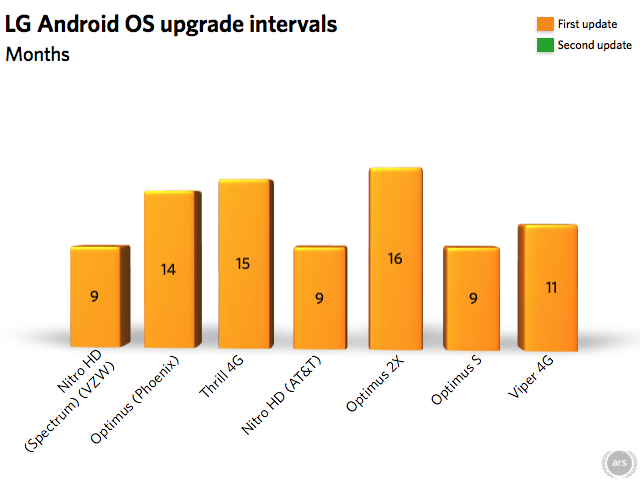
LG is one of the least prolific manufacturers here, and it happens to be the most lackadaisical about updates. The company let over a year pass for three of its phones before upgrading them to the next version of the operating system, and none of its phones received an update sooner than nine months after Google released a new OS version. LG did not release a second update to any of its handsets (presumably because it takes too long with the initial updates). An LG phone also holds the record for longest update holdout, with the Optimus 2X taking 16 months to go from Android 2.2 to 2.3.
LG phones average 11.9 months between an OS version release and the update reaching the phone.
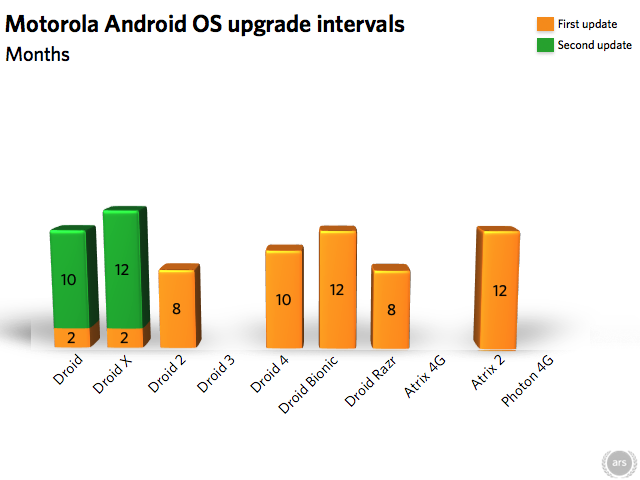
Motorola also has one of the smaller pools of phones, but it is the next least diligent company when it comes to updates. All but one of its phones received one update or less. Three of them—the Droid 3, Atrix 4G, and Photon 4G—never received updates at all (the Atrix 4G was famously promised Android 4.0 before Motorola reneged). Two phones took over a year to get updates, and only two phone received any updates in less than six months—the original Droid, released in late 2009, when it was updated from Android 2.0 to 2.1; and the Droid X, going from 2.1 to 2.2 in 2010. Motorola fares significantly better in its average time-to-update, though, at 8.4 months over all its phones.
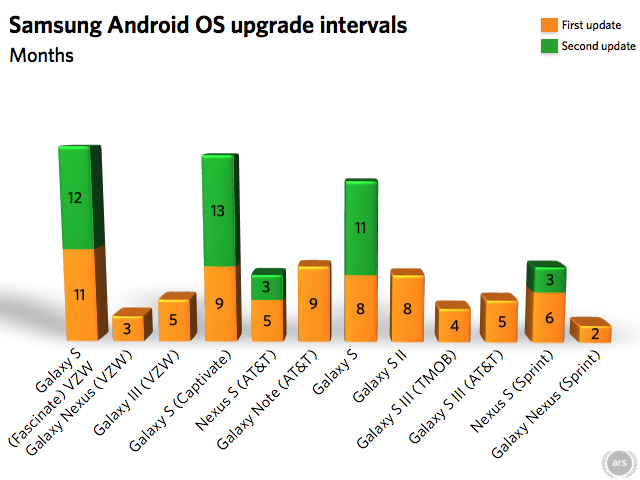
Samsung as a whole works harder at keeping its phones current. Five of the 12 phones we studied received two updates during their lifetimes (and some, like the Galaxy S III, are not new enough for a second update to be on the table yet). Still, only six of the 17 updates were issued six months or less after Google made the new OS version available.
Samsung benefits a bit in this area from having released multiple versions of two Google partnership phones, the Galaxy Nexus S and Galaxy Nexus. In fact, the only OS update that took less than six months and that did not benefit from the Google-Samsung relationship was the Galaxy S III, which was updated from Android 4.0 to 4.1 in five months. Samsung averages a 6.9 month lag between updates.
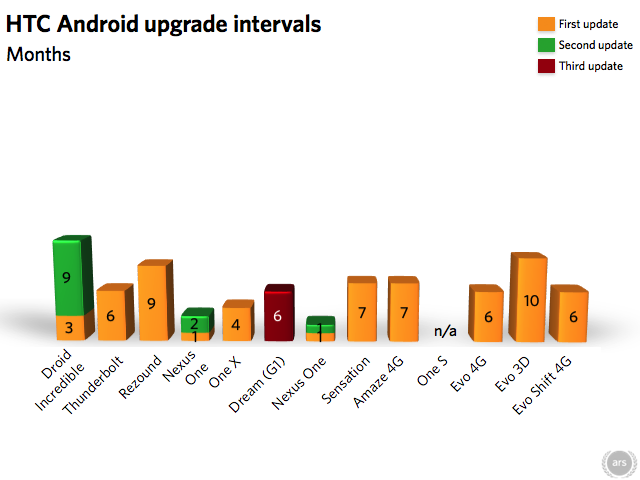
Although HTC is now one of the less popular manufacturers, it has been the overall winner in terms of getting updates out to users quickly. Like Samsung, it benefits from Google partnerships, particularly in the early days. HTC made the first Android handset, the Dream/T-Mobile G1, which received its first two updates the same month the updates were released (they're accounted for as "0"s in the chart above, which is why they don't appear). A later partnership handset, the Nexus One, had two versions on different carriers that got a total of four updates between them that took two months or less.
Of the phones surveyed, HTC has never lagged longer than a year between an update release and its issuance to a phone. The company's biggest offender was the Evo 3D, which didn’t get its update to 4.0 from 2.3 for ten months. HTC’s time-to-update average is a bit skewed due to the fact that it got in on the ground floor of Android when updates came relatively easily, but it is still the most impressive of all the manufacturers, with a 4.7 month update average.
Manufacturers, meet the carriers
When it comes to Android, carriers insist on testing and approving each update to each individual phone model before they can roll out over-the-air, so how smartphone companies and carriers work together matters—and it's too often ignored.

We’ll begin with Verizon, the worst carrier for OS update disbursement. Verizon beats AT&T by a small amount in its average time-to-update (eight months) but unlike AT&T, the company is consistently bad across manufacturers at distributing updates. Many of the long update times we saw from individual companies were on Verizon handsets, including most of Motorola’s phones, two of HTC’s highest update lags (Rezound, Droid Incredible) and one of Samsung’s (the Verizon version of the Galaxy S, or Fascinate). LG had the longest average update time on Verizon, though that’s only based on one phone; Motorola followed, despite its close relationship with the carrier, at 8.1 months. HTC and Samsung averaged 7.75 months each.
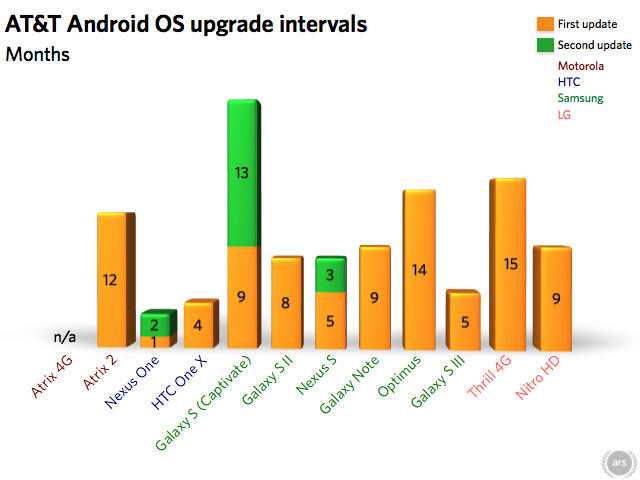
AT&T was not much better than Verizon, and it is home to some of the biggest update offenders, with an average update time of 7.8 months. LG does its second worst job here, averaging 12.7 months over three AT&T phones (two phones, the LG Phoenix and Thrill 4G, took well over a year). One of Motorola’s worst offenders, the Atrix 2, took 12 months to get an update on AT&T, and its Atrix 4G never got an update at all. AT&T is really saved by its Google partnership handsets, with HTC’s Nexus One and Samsung’s Galaxy Nexus and Nexus S doing business on its service. Largely because of the partnership, HTC on AT&T has a low update lag time of 2.3 months, while Samsung has 7.4 months.
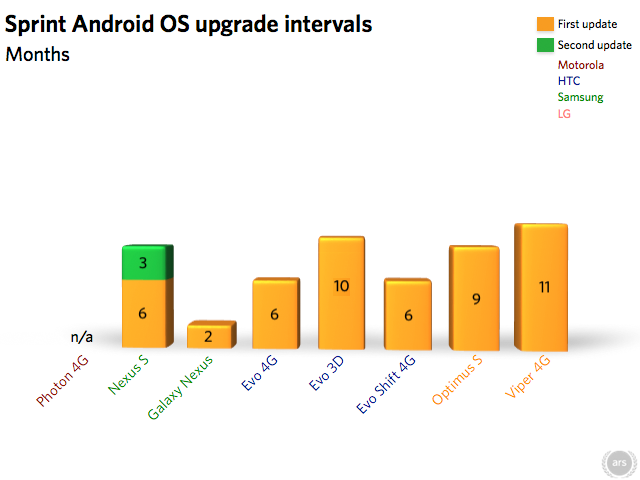
Sprint proved more timely than either AT&T or Verizon, with an average lag time of 6.5 months. It’s helped out by having only two Samsung phones, both of which were Google partnerships (the Nexus S and Galaxy Nexus). Samsung averages a 3.7-month lag on Sprint. Sprint also gets HTC on some of its weaker showings with its Evo series; however, at least no HTC phones here took over a year to get updates on Sprint (the average time was seven months). LG drags things down with an average lag time of 10 months, and Motorola sags here too with one phone, the Photon 4G, which was never updated.

The nimblest of all the carriers, surprisingly, is T-Mobile, at an average delay of 5.8 months. Again, the G1 skews the stats, but HTC is about as well-behaved here as it is on Sprint, with no update times even close to a year and with two Google partnership handsets (Nexus One and G1). LG’s biggest update lag came with its only T-Mobile phone, the Optimus 2X (which took 16 months to see an update). Samsung and T-Mobile actually perform as poorly together as Samsung and Verizon when it comes to updates, averaging 7.8 months on the Galaxy S series. Motorola has made no high-profile phones for T-Mobile.
The pointing of fingers, the hurling of accusations
Scientifically speaking, the data set for Android updates remains relatively small. After all, the operating system has only existed for a little over four years. For the first two years, only a handful of Android phones existed; in the following two years everything scaled up rapidly, to hundreds of millions of handset sales worldwide on dozens of carriers beyond the ones evaluated here.
Even the notion itself of software updates after hardware release is still a relatively new concept, let alone the idea that hardware owners are entitled to feature-based updates. Everyone involved is still getting the hang of this. While we can look at the numbers and try to draw conclusions, there may be factors that we, as outsiders to these companies, can’t account for here. Some handsets may receive late or no updates because they sold poorly, or because they were held back or delayed because of a company’s UI overlay.
Still, laid out like this, the landscape of Android updates doesn't look great. Updates that take less than six months to reach phones remain rare overall, and these are increasingly rare in recent months. The gap between Verizon and T-Mobile averages are small—no one's pushing these updates out quickly—but maybe T-Mobile hasn’t been getting its due in this regard. It does remain the fastest by a couple of months, on average.
Given Motorola’s long history and entrenchment in the Android scene, we were surprised to see it perform so poorly. Likewise, Samsung is far and away the biggest and most successful Android smartphone maker in terms of carrier coverage and sales, yet it’s not serving customers as well as it could be.
While HTC comes out on top, we suspect this is largely due to its canniness in dealing with Google. HTC hasn’t produced many bestsellers and its overall sales are modest relative to its competitors, but being the first to step up as Google’s flagship partner and sticking close ever since seems to have served the company well. But the circumstances that afforded it early, near-instant updates on its flagship are a mere memory now; we can mostly discount them for the purposes of predicting upgrade behavior in the future.
We hesitate to highlight one combination of carrier and manufacturer as the best, particularly since the best-performing partnerships seem to be a result of Google’s close involvement. If you like your updates on the timely side, your best bet is to follow that Google flagship, no matter the allied carrier or manufacturer.
We see glimmers of hope in the HTC/Sprint relationship, and to a lesser extent in that between Samsung and AT&T. In fact, the more recent Galaxy S phones got their most recent updates (Android 4.1 Jelly Bean) relatively quickly, so hopefully that’s a sign of good things to come.
Updates certainly aren't the most important aspect of picking a new phone—if an OS version works well, then you may be content simply to stick with that. But for those who like the latest and greatest, it’s clear that the need for update improvements plagues the entire Android ecosystem.
reader comments
155